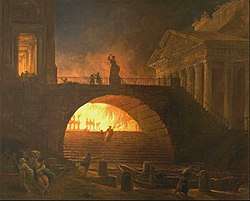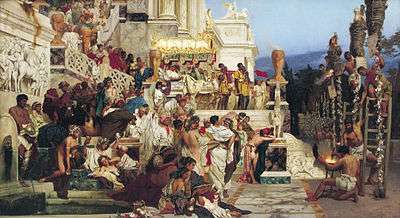Great Fire of Rome
The Great Fire of Rome (Latin: Ignem magnum imperium), was an urban fire that occurred in July, 64 AD.[1] The fire began in the merchant shops around Rome's chariot stadium, Circus Maximus, on the night of July 19. After six days, the fire was brought under control, but before the damage could be measured, the fire reignited and burned for another three days. In the aftermath of the fire, two thirds of Rome had been destroyed.[2]

According to Tacitus and later Christian tradition, Emperor Nero blamed the devastation on the Christian community in the city, initiating the empire's first persecution against the Christians.[3] However, some modern historians, including the Princeton classicist Brent Shaw, have cast doubt on the traditional view that Nero blamed the Christians for the fire.[4][5]
Background
Nero
Nero was proclaimed emperor in 54 AD at the age of 16.[6] His rule has commonly been associated with impulsiveness and tyranny. Early in his rule, he was heavily advised, but he slowly became more independent. In 59 AD, encouraged by his mistress Poppaea, Nero murdered his mother. His leading adviser, Seneca, was discharged and forced to commit suicide. After the Great Fire of Rome occurred in 64 AD, it was rumored that Nero ordered the fire to clear space for a new palace.[7]
Tacitus
Publius Cornelius Tacitus was a senator and historian of the Roman Empire. His exact birth date is unknown, but most sources place it in either 56 or 57 AD. His two main works, the Annals and the Histories, covered the history of the empire between 14 AD and 96 AD. However, much of the work has been lost, including the books covering events after 70 AD. He was only 8 years old at the time of the fire, but he was able to use public records and reports to write an accurate account.[8]
Outbreak and progress of fire
According to Tacitus, the fire began in shops where flammable goods were stored, in the region of the Circus neighboring the Caelian and Palatine Hills of Rome. The night was a windy one and the flames rapidly spread along the full length of the Circus. The fire expanded through an area of narrow, twisting streets and closely located apartment blocks. In this lower area of ancient Rome there were no large buildings such as temples, or open areas of ground, to impede the conflagration. It then spread along the Palatine and Caelian slopes. The population fled first to areas unaffected by the fire and then to the open fields and rural roads outside the city. Looters and arsonists were reported to have spread the flames by throwing torches or, acting in groups, hindering measures being made to halt or slow the progress of the flames. The fire stopped after six days of continuous burning. However, it soon reignited and burned for another three days.[9]
Aftermath

According to Tacitus, Nero was away from Rome, in Antium, when the fire broke out. Nero returned to the city and took measures to bring in food supplies and open gardens and public buildings to accommodate refugees.[10] Of Rome's 14 districts, 3 were completely devastated, 7 more were reduced to a few scorched and mangled ruins and only 4 completely escaped damage. The fire destroyed mostly everything it came in contact with due to poorly built and maintained timber-framed homes. The Temple of Jupiter Stator, the House of the Vestals, and Nero's palace, the Domus Transitoria were destroyed. Also destroyed in the fire was the portion of the Forum where the Roman senators lived and worked. However, the open mall in the middle of the Forum remained and became a commercial centre.[11] The accusations of Nero having started the fire were further exacerbated by his quickness to rebuild burned neighborhoods in the Greek style and to launch construction of his new palace. The new palace, known as Golden House, would have been massive, covering a third of Rome.[12]
Varying historical accounts
The varying historical accounts of the event come from three secondary sources—Cassius Dio, Suetonius and Tacitus. The primary accounts, which possibly included histories written by Fabius Rusticus, Marcus Cluvius Rufus and Pliny the Elder, do not survive. At least six separate stories circulate regarding Nero and the fire:
- Motivated by a desire to destroy the city, Nero secretly sent out men pretending to be drunk to set fire to the city. Nero watched from his palace on the Palatine Hill singing and playing the lyre.[13]
- Nero was motivated to destroy the city so he would be able to bypass the senate and rebuild Rome in his image.[14]
- Nero quite openly sent out men to set fire to the city. Nero watched from the Tower of Maecenas on the Esquiline Hill singing.[15]
- Nero sent out men to set fire to the city. There were unconfirmed rumors that Nero sang from a private stage during the fire.[16]
- The fire was an accident that occurred while Nero was in Antium.[17]
- Rumor had it that Nero had started the fire. Therefore, to blame someone else for it (and thus exonerate Nero from blame), the fire was said to have been caused by the already unpopular Christians.[18]
Cultural references
- Henryk Sienkiewicz's historical fiction Quo Vadis heavily implies that Nero ordered Tigellinus to set fire to Rome. In the novel, Nero repeatedly complains of Rome's smell, expresses a desire to replace its squalid neighborhoods with a more beautiful city, and seeks inspiration to write a poem or song that would outdo the works of Homer or Vergil describing the burning of Troy.
- In the 4th episode of the 1965 Doctor Who serial The Romans the Doctor accidentally ignites Nero's plans for a new Rome, giving Nero the idea to burn Rome so that the Senate would be forced to rebuild Rome his way.
- The computer program for optical disc authoring, Nero Burning ROM, was named in reference to Nero and his association with the Great Fire of Rome.
- The Norwegian band Ulver released an album entitled The Assassination of Julius Caesar in 2017, which opened with a song called "Nemoralia", about the Great Fire of Rome. The lyrics include, "Nero lights up the night/18th to 19th of July, AD 64", among other references to this historical event, though the word "fire" is never explicitly mentioned.
See also
Notes and references
- Society, National Geographic (2014-06-18). "Great Fire of Rome". National Geographic Society. Retrieved 2019-04-07.
- "The Great Fire of Rome | Background | Secrets of the Dead | PBS". Secrets of the Dead. 2014-05-29. Retrieved 2019-04-07.
- Dando-Collins, Stephen (2010). The Great Fire of Rome. Da Capo Press. ISBN 978-0-306-81890-5.
- Shaw, Brent (2015-08-14). "The Myth of the Neronian Persecution". The Journal of Roman Studies. 105: 73–100. doi:10.1017/S0075435815000982.
- Carrier, Richard (2014-07-02). "The prospect of a Christian interpolation in Tacitus, Annals 15.44". Vigiliae Christianae. 68(3): 264–283. doi:10.1163/15700720-12341171.
- "The Great Fire of Rome | Background | Secrets of the Dead | PBS". Secrets of the Dead. 2014-05-29. Retrieved 2019-11-29.
- Freeman, Charles (2014). Egypt, Greece, and Rome : civilizations of the ancient Mediterranean (Third ed.). Oxford. ISBN 978-0199651917. OCLC 868077503.
- "Tacitus | Roman historian". Encyclopedia Britannica. Retrieved 2019-04-13.
- Tacitus, Publius. The Annals.
- "The Great Fire of Rome | History Today". www.historytoday.com. Retrieved 2019-11-29.
- "The Great Fire of Rome | Clues and Evidence | Secrets of the Dead | PBS". Secrets of the Dead. 2014-05-29. Retrieved 2019-04-07.
- "Nero | Biography & Accomplishments". Encyclopedia Britannica. Retrieved 2019-04-07.
- Dio, Cassius History of Rome LXII. p.111-113
- "The Great Fire of Rome | Background | Secrets of the Dead | PBS". Secrets of the Dead. 2014-05-29. Retrieved 2019-11-29.
- Suetonius. "Life of Nero". Lives of Twelve Caesars.
- Tacitus, Annal XV.38–44
- Tacitus, Annals XV.38–9
- Tacitus, Annals XV.44
Bibliography
- Cassius Dio, Roman History, Books 62 (c. 229)
- Suetonius, The Lives of Twelve Caesars, the Life of Nero, 38 (c. 121)
- Tacitus, Annals, XV (c. 117)
External links
- Tacitus describes the great Fire (in English)